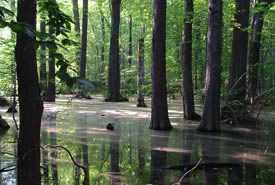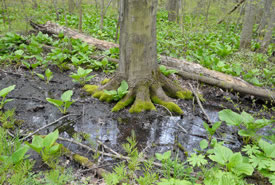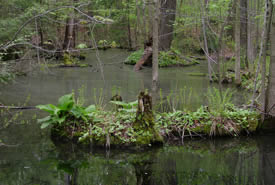Wetlands

Forested wetlands in summer (Photo by Mary Gartshore)
Wetlands are unique, nutrient-rich ecosystems where terrestrial and aquatic habitats meet. They are formed when water is trapped through poor drainage, occasional flooding or coastal barriers such as sandbars.
The Atlas of Canada defines wetlands as: "lands permanently or temporarily submerged or permeated by water, and characterized by plants adapted to saturated-soil conditions."
Wetlands of Backus Woods
Backus Woods is home to several different types of wetlands, including:
- Pits and mounds: areas where large, mature trees have fallen, leaving depressions in the ground from the uprooted root mass and mounds where the roots begin to decay.
- Yellow birch, red maple and silver maple swamp forests: flooded sections of woods that provide important habitat for many species, including wood ducks, song birds and amphibians. These can be found along the Wetland Trail.
- Floodplain forests: areas where black ash, American elm, eastern hemlock, cottonwoods and blackgum are found together, in the bottomlands of Backus Woods.
- Open canopy buttonbush swamp: a unique wetland found along the Weston Family Trail in the north tract of Backus Woods. Unlike most of the forests, the canopy here is open and devoid of large trees, since the swamp is too wet for hardwood species to germinate.

Vernal pool (Photo by Bernt Solymar)

Spring swamp, ON (Photo by Mary Gartshore)
Supported by the Weston Family Foundation.




